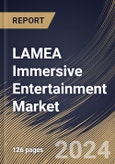The Latin America, Middle East and Africa Immersive Entertainment Market would witness market growth of 28.1% CAGR during the forecast period (2023-2030).
Immersive technologies are making significant inroads in healthcare, from medical training simulations to therapeutic applications. VR offers immersive and personalized interventions for exposure therapy, pain management, and rehabilitation programs. The education sector has embraced immersive technologies as powerful tools for enhancing learning experiences. Virtual classrooms, simulated environments, and VR-based training programs enable students and professionals to engage in realistic scenarios, facilitating skill development and knowledge retention.
Brands are leveraging immersive experiences to create memorable and impactful marketing campaigns. AR applications allow consumers to visualize products in their environments before purchasing, enhancing the online shopping experience. Immersive marketing strategies aim to forge deeper connections between brands and consumers. The rapid evolution of immersive technologies is a key factor driving the market. Advancements in hardware, software, and connectivity contribute to developing more sophisticated and accessible immersive experiences.
According to UAE Stat, the total disposable income in UAE was 1,100,319 AED in 2020. Higher-income levels allow for the adoption of cutting-edge entertainment technologies. Consumers in the UAE may invest in the latest VR headsets, AR glasses, and other immersive devices. This form of entertainment may extend into luxury hospitality and tourism experiences. Individuals with higher disposable income may seek exclusive immersive experiences as part of premium travel packages or luxury resort offerings. The disposable income allows individuals in the UAE to participate in immersive events and attractions. Whether VR-themed events, escape rooms, or interactive exhibitions, customers are more likely to explore and engage in exclusive immersive experiences. As a result, these aspects will boost market growth in the coming years.
The Brazil market dominated the LAMEA Immersive Entertainment Market, by Country in 2022, and would continue to be a dominant market till 2030; thereby, achieving a market value of $8,209.5 Million by 2030. The Argentina market is showcasing a CAGR of 28.8% during (2023 - 2030). Additionally, The UAE market would register a CAGR of 27.7% during (2023 - 2030).
Based on Technology, the market is segmented into Virtual Reality (VR), Augmented Reality (AR), Mixed Reality (MR) and Others. Based on Application, the market is segmented into Gaming, Music & Concerts, Immersive Theater, Arcade Studios, Live Events, Sports, Museum & Cultural Experiences and Others. Based on countries, the market is segmented into Brazil, Argentina, UAE, Saudi Arabia, South Africa, Nigeria, and Rest of LAMEA.
Immersive technologies are making significant inroads in healthcare, from medical training simulations to therapeutic applications. VR offers immersive and personalized interventions for exposure therapy, pain management, and rehabilitation programs. The education sector has embraced immersive technologies as powerful tools for enhancing learning experiences. Virtual classrooms, simulated environments, and VR-based training programs enable students and professionals to engage in realistic scenarios, facilitating skill development and knowledge retention.
Brands are leveraging immersive experiences to create memorable and impactful marketing campaigns. AR applications allow consumers to visualize products in their environments before purchasing, enhancing the online shopping experience. Immersive marketing strategies aim to forge deeper connections between brands and consumers. The rapid evolution of immersive technologies is a key factor driving the market. Advancements in hardware, software, and connectivity contribute to developing more sophisticated and accessible immersive experiences.
According to UAE Stat, the total disposable income in UAE was 1,100,319 AED in 2020. Higher-income levels allow for the adoption of cutting-edge entertainment technologies. Consumers in the UAE may invest in the latest VR headsets, AR glasses, and other immersive devices. This form of entertainment may extend into luxury hospitality and tourism experiences. Individuals with higher disposable income may seek exclusive immersive experiences as part of premium travel packages or luxury resort offerings. The disposable income allows individuals in the UAE to participate in immersive events and attractions. Whether VR-themed events, escape rooms, or interactive exhibitions, customers are more likely to explore and engage in exclusive immersive experiences. As a result, these aspects will boost market growth in the coming years.
The Brazil market dominated the LAMEA Immersive Entertainment Market, by Country in 2022, and would continue to be a dominant market till 2030; thereby, achieving a market value of $8,209.5 Million by 2030. The Argentina market is showcasing a CAGR of 28.8% during (2023 - 2030). Additionally, The UAE market would register a CAGR of 27.7% during (2023 - 2030).
Based on Technology, the market is segmented into Virtual Reality (VR), Augmented Reality (AR), Mixed Reality (MR) and Others. Based on Application, the market is segmented into Gaming, Music & Concerts, Immersive Theater, Arcade Studios, Live Events, Sports, Museum & Cultural Experiences and Others. Based on countries, the market is segmented into Brazil, Argentina, UAE, Saudi Arabia, South Africa, Nigeria, and Rest of LAMEA.
List of Key Companies Profiled
- Meta Platforms, Inc. (Meta)
- Microsoft Corporation
- HTC Corporation
- Barco NV
- Magic Leap, Inc.
- Samsung Electronics Co., Ltd. (Samsung Group)
- Apple, Inc.
- Sony Corporation
- Qualcomm Incorporated (Qualcomm Technologies, Inc.)
- Unity Software, Inc.
Market Report Segmentation
By Technology- Virtual Reality (VR)
- Augmented Reality (AR)
- Mixed Reality (MR)
- Others
- Gaming
- Music & Concerts
- Immersive Theater
- Arcade Studios
- Live Events
- Sports
- Museum & Cultural Experiences
- Others
- Brazil
- Argentina
- UAE
- Saudi Arabia
- South Africa
- Nigeria
- Rest of LAMEA
Table of Contents
Chapter 1. Market Scope & Methodology
Chapter 2. Market at a Glance
Chapter 3. Market Overview
Chapter 4. Competition Analysis - Global
Chapter 5. LAMEA Immersive Entertainment Market, by Technology
Chapter 6. LAMEA Immersive Entertainment Market, by Application
Chapter 7. LAMEA Immersive Entertainment Market, by Country
Chapter 8. Company Profiles
Companies Mentioned
- Meta Platforms, Inc. (Meta)
- Microsoft Corporation
- HTC Corporation
- Barco NV
- Magic Leap, Inc.
- Samsung Electronics Co., Ltd. (Samsung Group)
- Apple, Inc.
- Sony Corporation
- Qualcomm Incorporated (Qualcomm Technologies, Inc.)
- Unity Software, Inc.
Methodology

LOADING...








